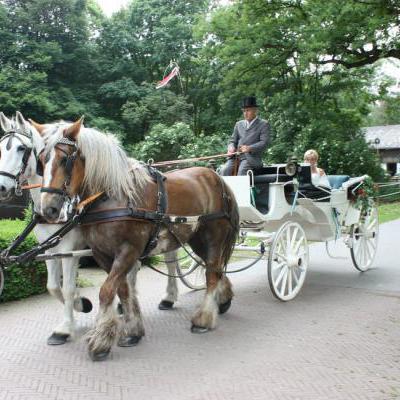Hairstylist (Haarstylist)
Information on this skill...
A hairstylist is a hairdresser who takes care of clients' hair. The work varies from washing, cutting and blow drying to coloring the hair and putting in perms. Within the profession of hairstylist there are specializations to distinguish, such as putting dreadlocks, taking care of black hair or applying extensions. Another specialization is a men's hairdresser who performs work as a barber with shaving faces or with mustaches and beards in model cutting and trimming. The other tasks of a hairstylist include giving advice, such as on the choice of a hair color. In that respect, a hairstylist is not only a hairdresser but also a color consultant. Giving advice also relates to the care of the hair, such as which shampoo and conditioner is suitable. The hairstylists are usually trained as all-round hair specialists to cut women, men and children. Most hairstylists work in a hair salon. There are also hair specialists who work on site, such as in retirement homes or hospitals. In addition, there are hair stylists who combine the work of a hairdresser and makeup artist. In the hair salon, the hairstylist is also responsible for cleaning the workplace, such as wiping away the hair. Offering a cup of coffee or tea is also part of the work in the context of customer friendliness. Furthermore, the hairstylist pays at the cash register after the haircut or other hair treatment. In addition, depending on the agreements on the tasks, the hairstylist has the responsibility to take reservations. The profession of hairstylist therefore includes more tasks than just activities that are specifically aimed at hair care. For example, customer friendliness plays a major role, as does the advisory task in the field of hair care.
The hairdressing industry is large in the Netherlands with the presence of tens of thousands of hair salons and even more hair stylists. Most of these cases are in the hands of independent entrepreneurs. Some of them work entirely for themselves and another part employs hairstylists as staff. There are all-round barbershops with hairstylists who cut both ladies and gentlemen. In addition, there are barber salons and salons for women as well as salons for men. In addition, there are also black hair hair salons. There are several ways to get started in the profession of hairstylist. For example, by working at a barbershop. Or by starting your own business. In the latter case, there are all kinds of things to think about. For example, finding a suitable building and purchasing the interior, such as barber chairs, mirrors and hair products.
INDEPENDENT HAIRSTYLIST
If you are going to work as an independent entrepreneur in this industry, you will have to deal with all kinds of parties, such as suppliers and representatives. In addition, for having your own salon, it is important to keep the accounts. An accountant can possibly be called in for this, but it is also possible to do it yourself. There are opportunities for self-employed hairstylists to join the interest group for hairdressers, such as ANKO. This is the General Dutch Hairdressers Organization that focuses, among other things, on a number of core values. It is about respect for the craftsmanship of hairstylists as well as about space to do business. Good employment practices and fair competition are also an important theme within this hairdressing organisation. As an independent entrepreneur in the profession of hair stylist, it is also possible to work as a home hairdresser.
FURTHER TRAINING HAIRDRESSER
The training to become a hairstylist is partly dedicated to gaining practical experience. This means that the student takes models to the practical lessons to practice on. After the two-year training, it is possible to move on to the MBO all-round hairdresser course at level three. Further development is possible in the form of training as a salon manager. Or to realize further deepening in the industry of hairdressers and beauticians by following a training to become a beautician. Incidentally, it is also possible to learn specific skills as a hairstylist, such as at the Hairdressing Academy. Or to teach her how to braid and teach her how to raise her. Basic techniques can be learned with short courses by following a home study.
WHAT DOES A HAIRSTYLIST DO:
- Cutting and trimming moustaches and beards
- Advising on hair care
- Wash, cut and blow dry
- Apply extensions
- Permanent application
- Give colour advice
- Putting dreadlocks
- Black hair kapper
- Setting highlights
- Haarverven
- Shear
- Style
PROFESSION HAIRSTYLIST:
TRAINING TO BECOME A HAIRSTYLIST
There is a special training to follow to carry out the profession of all-round hairstylist, namely the MBO training all-round hairdresser. This training can be followed at a regional training centre and takes a total of three years. In the past, there was still a distinction between the women's and men's hairdressing profession. That is no longer the case today, because there is now a general education. There are also shorter courses to follow, such as a two-year training to become a hairdresser at MBO level. In this training there is attention for learning the basic actions, preparation and completion. The basic treatments consist of cutting, blow drying, styling, coloring and decolorization. Furthermore, attention is paid to learning to make appointments and to receive customers. Finally, education is focused on the care of hair and scalp and on the sale of hair products. In addition, there are plenty of external training institutes where you can follow a course. Accounting is also important as an entrepreneur.
COMPANIES WHERE A HAIRSTYLIST MAY WORK
A hairstylist usually works for a barbershop, such as a hair salon. In addition, a hairstylist can work as an entrepreneur within his own hair salon. There are many hairdressers working as entrepreneurs, who can also work as home hairdressers. A home hairdresser has his own cutting salon at home. A hairdresser who works on location must be classified as an itinerant hairdresser. In some cases, a hairdresser can be classified as a franchisee. In that case, you are working as an entrepreneur under a national organization.
COMPETENCES HAIRSTYLIST
The most important competence of a hairstylist is the all-round professional knowledge of hair and hair techniques. In addition, a hairstylist must have the necessary creativity and inspiration. Another important competence is communication, because a hairstylist has a lot to do with different customers. In addition, as a hairstylist you will have to stay up to date with the latest techniques, resources and trends. Generally important words are hygiene, flexibility, passion, motivation, listening, planning, organizing, independence and stress resistance. If you work as an entrepreneur, networking is also important.
LABOUR MARKET PERSPECTIVE AND CAREER OPPORTUNITIES AS A HAIRSTYLIST
The job market perspective of a hairstylist is good if you have the right education and experience. It is true that many hairstylists sooner or later start their own hair salon. In general, a good hairstylist, who moves with the times, will have no trouble finding work. The career opportunities of a hairstylist can be seen in the position of salon manager. As a salon manager you are responsible for the daily management of the hairdressing salon and responsible for making the personnel planning. Starting your own barbershop can also be seen as growing within your career. Another possibility is to specialize further. Consider, for example, the profession of make-up artist. Starting your own beauty channel can also help enormously to work on brand awareness.
TERMS OF EMPLOYMENT AND SALARY HAIRSTYLIST
In most cases, a hairstylist will fall under the collective labour agreement for hairdressers, within which the terms and conditions of employment are regulated depending on the employer. An employed hairstylist earns between 1800 and 2400 euros gross per month, depending on age, experience and further responsibilities. What exactly a self-employed hairstylist will earn is not easy to indicate. This depends entirely on the expenses, the rent and the number of customers. In general, a self-employed hairstylist will be able to earn more.
The content on this page has been automatically translated from the Dutch language. For this reason, texts and videos on this page may contain small errors.
Lees deze informatie over Haarstylist in het Nederlands.
Mijnzzp.nl


